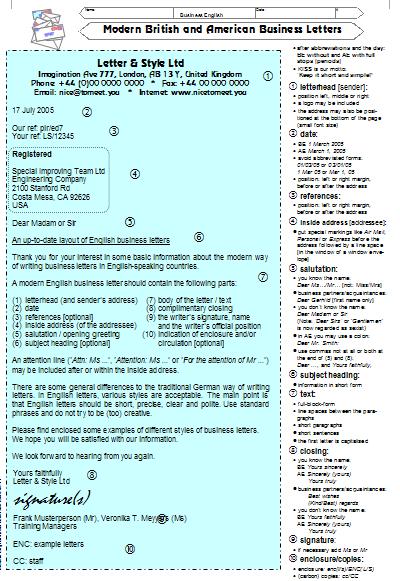Business letter
This article's tone or style may not reflect the encyclopedic tone used on Wikipedia. |
A business letter is a letter written in a formal language, usually used when writing from one business organization to another, or for correspondence between such organizations and their customers, clients and other external parties. Business letters usually follow a block format.
Parts of a Business Letter
Business Letters in the United States usually contain the following information (in this order):
- Letterhead or sender's address
- Date
- Inside address
- Greeting
- Letter body
- Complimentary closing
- Signature, printed name, and position of sender
In some situations, a business letter may also include the following optional information:
- Reference (RE:)
- Carbon Copy Recipients (CC:)
- Enclosures (ENC:)
- Reference Initials
Business Letter Layout Guidelines
Addresses
The address is generally written from the most specific information (i.e. the recipient's name) to the most general (i.e. the city, state, ZIP Code or country). If you know the recipient's gender, include a courtesy title (Mr. or Ms.).
Example of Address Line:
| Mr. Bill Duffy |
| Director of Marketing |
| Acme Industrial, Inc. |
| PO Box 148761 |
| Shirley, New York 11967 |
Dates
The date can go in one of two places – beneath your address or beneath the reader’s address.
It is always best to write the month in full because the British dating system is different to the American dating system (eg: 8/10/2002 is 8th October 2002 in Britain but August 10th in America).
Note that you do not need to write ‘the’ or ‘of’ in a date (eg: ‘the 16th of October’ October 2004.
Note: the correct grammatical form for writing a date in full is 16 October 2004. The 'th', 'st' or 'rd' after a number should only be spoken, not written.
Names
Although rules have relaxed over the years, it is still important to address someone correctly. This will depend on your relationship with the reader:
Informal or Neutral: Dear Peter: …
Formal: Dear Mr. Galanaugh: …
The formal style is reserved for customers, members of the public or people in high authority. Unless a man is entitled to a different style, such as Rev. or Dr., then a man should be addressed as Mr (ie: Mr Grant). Never write out the title in full (ie: ‘Mister Grant’ is wrong).
The greeting should always end in a colon (:), not a comma.
When writing to a woman, you need to be aware of her marital status.
Married women: Mrs Collins
Status unknown: Ms Peterson
Some women prefer to use the title Ms because they do not wish to reveal their marital status. Always check which title she has used in previous correspondence. If you’re not sure then the safest option is always Ms.
Greetings and endings
The word ‘dear’ always comes before the name of the person you are writing to, even if you don’t know them. However, what follows after ‘dear’ determines how you are going to write the ending of your business letter.
If your letter begins ‘Dear Ms Foster’, ‘Dear Gary Stewart’, ‘Dear Wendy’, etc, then your letter should end with ‘Yours sincerely’.
If your letter is informal or neutral in style and you know the person fairly well, then you can use ‘Best wishes’, or ‘Kind regards’ instead.
If you do not know the name of the person you are writing to then your greeting should be ‘Dear Sir or Madam’ and your ending should be ‘Yours faithfully’.
In the US, any business letter may end with 'Sincerely, [Sender's Name]', but is not limited to that. Some may end with 'Sincerely Yours, [Sender's Name]' Yours Truly, [Sender's Name], etc. depending on the relationship.
Headings
It is always best to give a heading to a business letter. This helps to ensure that your letter is dealt with as efficiently as possible.
Headings come immediately after the greeting, and should be underlined or typed in bold. Make your heading brief and specific. For example:
Dear Sir or Madam,
Closure of bank account no. 56777889
I would like to inform you ……..
Different countries, different styles
Culture and society influence styles. Especially in the German speaking countries, formal rules are considered very important. An extreme example is the German industrial norm DIN 5008, which prescribes how to write German business letters in every detail from letterhead to closing as shown below and as explained in German here.
Examples:
These two examples from business trainings at schools are used to show how nice formal letters look.
Modern British and American business letter:
Please note that this is a voluntary style, not a "must".
Modern German business letter:
Please note this example shows what is mandatory according to the German industrial norm.
Another example of an English business letter
External links
- Business Letter Generator - Online form that can be used to download a block-style business letter


